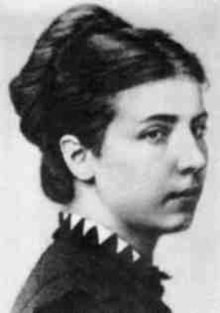Elisabeth Dmitrieff
show This article may be expanded with text translated from the corresponding article in French. (May 2021) Click [show] for important translation instructions. |

Elisabeth Dmitrieff (real name: Elizabeta Luknichna Tomanovskaya (née Kusheleva); Russian: Елизавета Лукинична Томановская (née Кушелева); 1 November 1850, , now in Toropetsky District, Tver Oblast – 1910 or 1918) was a Russian-born feminist and revolutionary of the 1871 Paris Commune. Born Elisaviéta Loukinitcha Koucheleva, she was a co-founder of the , created on 11 April 1871, in a café of the , with Nathalie Lemel.
Life[]
Elisabeth Dmitrieff was the daughter of a Tsarist official and a German nurse.[1] Born out of wedlock, her and her sister were barred from attending an elite girls’ school on grounds of illegitimacy, despite her brother being granted a place in an elite boys’ school.[2]
As a young teenager, she read Nikolai Chernyshevsky's novel What Is to Be Done?, which greatly inspired her political thinking and activities.[3] She was active in her youth in the Socialist circles of Saint Petersburg,[4] and tried to organize a cooperative mill at the age of sixteen.[3] In 1868, she travelled to Geneva to pursue her education, as Switzerland was one of the few countries at the time that allowed women to attend university.[4] In Geneva, she co-founded the Russian section of the First International.[1] Delegated to London, she met Karl Marx there, and struck up a friendship with him and his family.
In March 1871, aged 20, the General Council of the International sent her to cover the events of the Paris Commune. Dmitrieff finally became a participant in these events, founding with Nathalie Lemel the Women's Union for the Defense of Paris and Care of the Wounded on 11 April 1871. She dedicated herself especially to political questions and the organisation of cooperative workshops.[1]
Elisabeth Dmitrieff contributed to the Socialist newspaper La Cause du peuple. After having fought on the barricades during the Bloody Week, she fled to Russia. Once arrived in her native country, she married a man who was later convicted of fraud and in 1878 followed him in deportation in Siberia, where she lived until 1902.[5]
Commemoration[]
The 3rd Arrondissement's municipal council of Paris decided on 27 March 2006 to give her name to a little square, between the rue du Temple and the rue de Turbigo (close-by to the Place de la République).[6] The Elisabeth Dmitrieff Square was inaugurated on 8 March 2007, for the International Women's Day, along with the squares commemorating Nathalie Lemel and Renée Vivien (in the same arrondissement).
See also[]
References[]
- ^ Jump up to: a b c François Bodinaux, Dominique Plasman, Michèle Ribourdouille. "On les disait 'pétroleuses'..." (in French) (archive) (PDF version)
- ^ Eichner, Carolyn J. (2021-04-02). "Elisabeth Dmitrieff: feminist, unionist, Communarde". Roar Magazine.
- ^ Jump up to: a b Ross, Kristin (2015). Communal Luxury: The Political Imaginary of the Paris Commune. London: Verso. ISBN 9781784780548.
- ^ Jump up to: a b Karina, Robyn (2017-07-28). "She stood on the barricades". LibCom.
- ^ Статья в энциклопедии "Мой Красноярск" XX век An encyclopedia article "My Krasnoyarsk", XX century, accessed 27 February 2020, region.krasu.ru
- ^ Municipal council decision of 27 March 2006[permanent dead link] (in French)
External links[]
- Héroïnes révolutionnaires russes du XIXe siècle, images, stéréotypes, mythes, pour quelles histoires?, by Sylvie Braibant, mémoire of History DEA at the École des hautes études en sciences sociales, 1992 (in French)
- Feminists of the Russian Empire
- 1850 births
- 1910s deaths
- People of the Paris Commune
- Members of the International Workingmen's Association
- 19th-century Russian actresses
- Russian stage actresses
- 19th-century Russian people
- 19th-century women politicians
- Socialist feminists
- Emigrants from the Russian Empire to France